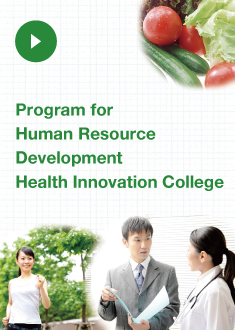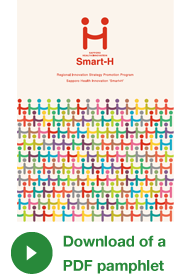Creation of the Hub of Health Science and Medical Integration
Research Project
- Column 1
- Reinforcement of the capability of analysis and evaluation centering on food functionalities
- Column 3
- Reinforcement of the capability of analysis and evaluation centering on food functionalities
Column 1 : Reinforcement of the capability of analysis and evaluation centering on food functionalities

| Research Project | Intestinal bacteria and lipocyte evaluation |
|---|---|
“The basis of health maintenance through diet: Control of intestinal bacterial flora and adipocyte” |
|
| Lead researcher | Satoshi Ishizuka, Associate Professor, Research Faculty of Agriculture,Hokkaido University |
| Overview | High fat foods, particularly those with high sucrose contents, are believed to be one of the causes of metabolic syndrome. Those foods have also been found to cause changes in the intestinal flora. Similar changes in intestinal flora can be induced by the oral administration of bile acid. Through the profile analysis of the bile acid in the intestine and the analysis of intestinal flora, we can clarify the mechanism by which high fat foods cause metabolic syndrome. Furthermore, we can establish an experimental model to clarify the effect of food microorganisms, such as lactic acid bacilli and bifidobacteria, on the innate immunity of intestinal mucosa and adipose tissue. |
| Research Project | Digestion and absorption in the intestinal tract |
|---|---|
Platform development for absorption and activity evaluation of functional components of foodstuffs |
|
| Lead researcher | Takanori Moriyama, Visiting Professor, Health Sciences Faculty of Hokkaido University |
| Overview | Over 70% of food with health claims focusing on living body adjusting functionalities, such as “Food for Specified Health Use (FOSHU) and health-promotion food, fulfills its functions by associated with bowel actions. Health promotion foods may be divided into two broad categories when classifying them by scene where they exercise their functionalities. One is the group which functions after absorption through intestinal tract. The other group has a functional role before absorption because of poorly-absorbed property. The former one is health promotion foods for people who are concerned about blood pressure, neutral fat and bone health, and the latter is effective for improvement of intestinal bacterial flora and for control of digestion absorption of nutrients. <Sub-projects>
|
| Research Project | Advanced lipid analysis |
|---|---|
“The development of new analysis technique to support health improvement through diet and the formation of local and extended area network as well as international ones based on the Laboratory for Advanced Lipid Analysis” |
|
| Lead researcher | Shu-Ping Hui, Professor, Faculty of Health Sciences, Hokkaido University |
| Overview | It becomes more obvious that ectopic fat accumulation is a more serious problem than deposition of cholesterol with respect to adiposis. Ectopic lipids cannot be diagnosed in conventional blood tests because they are distributed inside cells. In this study, in addition to measuring trace amounts of neutral lipid at nanomolar levels which are undetectable by conventional methods, we will make it possible to determine the quantity of lipid stored within cells and will develop an assessment system focusing on obesity and lipid oxidation. We are performing these joint research and commissioned analysis projects using the various lipid analysis apparatus integrated into the Laboratory for Advanced Lipid Analysis. <Sub-projects>
|
| Research Project | Nuclear receptor assay system |
|---|---|
Development of assessment and analysis methods for functional components of Hokkaido’s food products with the nuclear receptor assay system and technology transfer to private businesses |
|
| Lead researcher | Naoki Morita, Group Leader, Bioproduction Research Institute, National Institute of Advanced Industrial Science and Technology Hokkaido (AIST Hokkaido) |
| Overview | “Nuclear receptor assay system” is one of the most useful methods to evaluate functionalities of food. AIST Hokkaido possesses over 20 varieties of receptor assay for evaluation. That is the nation’s largest number. AIST Hokkaido also has advanced its research in order to facilitate assay systems and to reduce costs through the development of basic technologies of the world’s first nuclear receptor assay by luminescence of secretional luciferase. In this project, AIST Hokkaido will transfer the nuclear receptor assay technology to a private business which has its own animal testing system. It is expected the establishment of analysis service for functionalities of foodstuffs in Hokkaido by integrating of both technologies. <Sub-projects>
|
| Research Project | Antioxidant property analysis |
|---|---|
Creation of a new model of preventive medical care at local community based on food functionalities with the antioxidant ingredient database |
|
| Lead researcher | Nobutaka Wakamiya, Professor, School of Medicine, Asahikawa Medical University |
| Overview | The Research Center for Anti-oxidation Activity Analyses of Asahikawa Medical University has been analyzing the anti-oxidation ability of Hokkaido’s foodstuffs. The analyzed data and information of food ingredients are maintained in the antioxidant ingredient database and some of them have been released on the website. This study aims to improve infrastructure for research on food functionalities by the involvement of medical scientists and to establish an objective and transparent evaluation system focusing on antioxidative function of food with evidence-based analysis including clinical trials. <Sub-projects>
|
| Research Project | Human intervention study |
|---|---|
Establishment of the total health care system based on research of functionalities of foodstuffs and development of international cooperation network |
|
| Lead researcher | Jun Nishihira, Professor, Faculty of Medical Informatics, Hokkaido Information University |
| Overview | The “Ebetsu Model” for human clinical trials for food has been conducted at the Health Information Science Center, Hokkaido Information University. It has been developed in close collaboration with local community within the framework of the Regional Innovation Strategy Promotion Program. Through the “Ebetsu Model”, researchers accumulate scientific evidence of the functionalities of foods, promote the general health conditions of community residents by utilizing foods rich in functionalities for maintaining and promoting health. Taking advantage of the model, the projects aim at the establishment of total healthcare system which integrates regional health promotion, preventive healthcare and nursing care support. <Sub-projects>
|
Column 2 : Establishment of “Hokkaido brand” and high added value food ingredients

| Research Project | Sturgeons |
|---|---|
“Development of sturgeon farming and techniques to utilize useful parts of the sturgeon” |
|
| Lead researcher | Yasuaki Takagi, Professor, Graduate School of Fisheries Science,Hokkaido University |
| Overview | The use of marine collagen has attracted attention due to the low risk of infectious pathogens compared with animal collagen. It becomes obvious that sturgeon collagen (especially type-II) has excellent characteristics such as a high denaturation temperature and high water affinity. This competence is expected to be used in areas of cosmetics (moisture retention, etc.) and medical supplies (substrate for cartilage regeneration, etc.). Together with advanced research into the use of sturgeon collagen, we will develop sturgeon farming techniques for caviar to expand on its use for promoting regional industry developments. <Sub-projects>
|
| Research Project | Sphingolipids/ceramides |
|---|---|
“The formation of a world center for sphingolipid health science and the development of drugs and functional foods that focus on its anti-aging properties” |
|
| Lead researcher | Yasuyuki Igarashi, Professor, Faculty of Advanced Life Science,Hokkaido University |
| Overview | We will elucidate whether functional materials in foods (sphingolipids, ceramides) are absorbed from the intestinal tract and will clarify the mechanism of the functionalities of absorbed materials. With the results of our research, we will develop new pharmaceuticals and utilize the fruits of our research in new industries. In addition, we will establish a hub of research and development by cooperating with companies through joint research as well as creating a world-class network of researchers, the "Sphingo Cluster". <Sub-projects>
|
| Research Project | Medical plant cultivation system |
|---|---|
“Comprehensive research on plant cultivation systems under entirely artificial environments” |
|
| Lead researcher | Tomomi Marutani, Professor, Research Faculty of Agriculture,Hokkaido University |
| Overview | "The Entirely Artificial Environment Plant Factory" can control all conditions that are required to grow plants such as temperature and lighting. By utilizing the plant factory, we have established cultivation techniques of galenic plants of which supply depends largely on overseas. <Sub-projects>
|
| Research Project | Grifola frondosa |
|---|---|
“Verification of Grifola frondosa as a highly-functional prebiotic food and the dissemination of low-cost cultivation technology” |
|
| Lead researcher | Mayumi Sato, Senior Research Manager, Forest Research Department, Hokkaido Research Organization |
| Overview | Mushrooms exercise their various bio-functionality through an intestinal environment which is affected by intestinal bac-terial flora. However, the details of the mechanism are not yet clear. This research will evaluate the effects of dietary fiber and protein of the Taisetsu Hana No Mai No.1(the Hen of the Wood) on the enteral environment, and to clarify the mechanism of lipid metabolism and natural immunity enhancing effects brought by the changes in the intestinal environment. Moreover, based on the scientific evidence by the human interventional test, the Taisetsu Hana No Mai No.1 will be promoted as a functional food with the prebiotic effects. |
| Research Project | Sea urchin |
|---|---|
“The study of functional substances in sea urchin that may benefit human health - the plan to totally develop sea urchins in rocky-shore denudation into food products” |
|
| Lead researcher | Kazuhiro Ura, Assistant Professor, Graduate School of Fisheries Sciences,Hokkaido University |
| Overview | Research and development regarding improvement in total sea urchin utilization will be carried out. The sea urchins which live in rocky-shore denudation areas are unsuitable for consumption and may be a cause of rocky-shore denudation themselves. The research laboratory has developed a system that effectively cultures the unused sea urchins. This project will aim to develop and commercialize prebiotic functional food that benefits human health by utilizing sea urchins which are not well grown despite that system. |
Column 3 : Contributions to preventive medicine and overcoming common health problems around the world

| Research Project | Zoonotic disease, therapeutic and vaccines |
|---|---|
“Development and practical application of new diagnoses, prevention methods and treatments for influenza” |
|
| Lead researcher | Hiroshi Kida, Professor, Graduate School of Veterinary Medicine,Hokkaido University |
| Overview | Based on the fundamental research results related to influenza and respiratory diseases from the Research Center for Zoonosis Control, we will develop and commercialize adjuvants for infection inhibitors and vaccines, as well as therapeutic drugs and vaccines to prevent worsening of influenza and respiratory diseases. |
| Research Project | Development of the Real-time Tumor-tracking Proton beam Therapy System with Molecular Imaging |
|---|---|
“Health Innovation Project based on patient- friendly cutting-edge medical technology” |
|
| Lead researcher | Hiroki Shirato, Professor, Graduate School of Medicine,Hokkaido University |
| Overview | We are developing the world-leading real-time tumor-tracking Proton Beam Therapy System with Molecular Imaging, which is used in the medical treatment for liver cancer and other diseases. Based on the results of clinical research, we will establish a research platform for the "Program of Disease Prevention, Diagnosis, and Treatment Planning" which will meet international standards. We will also invite researchers worldwide to share disease information and treatment expertise. <Sub-projects>
|
| Research Project | Physical exercise and health |
|---|---|
“Realization of health-oriented society including physical exercise: Development of the index of immobilization and suitable kinetic therapy for Hokkaido” |
|
| Lead researcher | Koichi Okita, Professor, Graduate School of Lifelong Sport Hokusho University |
| Overview | In the effort to prevent against obesity by appropriately utilizing 'physical exercise' and 'food habits', this study will develop methods to assess and analyze the effectiveness of 'physical exercise' with a focus on myokine and brain-derived neurotrophic factors (BDNF). Furthermore, the research on the regional foodstuffs associated with the secretion of these substances will be conducted. First of all, the current status of immobilization of Hokkaido citizens will be analyzed. Based on the results of the survey, the fundamental physical strength, skeletal muscle mass, and amount of physical exertion which may contribute to extend a healthy life expectancy will be investigated. The optimal biomarkers will be obtained. Based on the findings from the study, assistive devices for physical exercise and guidelines for kinetic and behavior therapy adapted to cold and snowy regions will be developed. Consequently, by maximizing accumulated scientific knowledge, an innovation hub as well as anti-obesity science will be created. |
| Research Project | Cohort |
|---|---|
“Cohort study” |
|
| Overview | In Hokkaido, various types of cohort studies are conducted in cooperation with local communities, mainly by Sapporo Medical University. Through the utilization of these organizational frameworks and databases, the long-term effects on health caused by Hokkaido's foodstuffs will be considered as well as the awareness toward health of local residents will be evaluated. |













